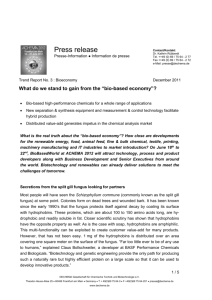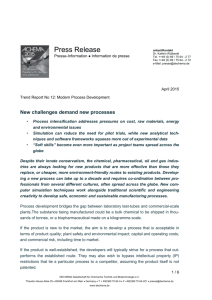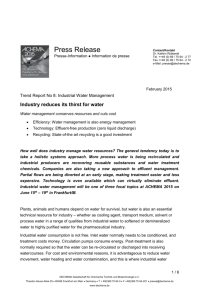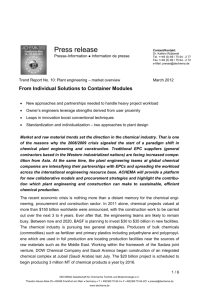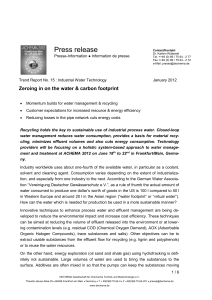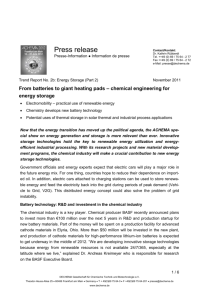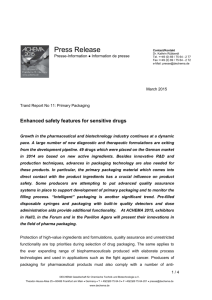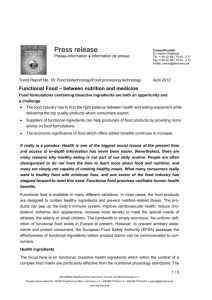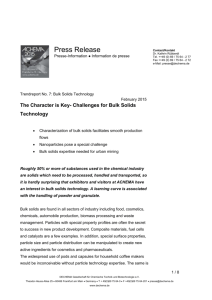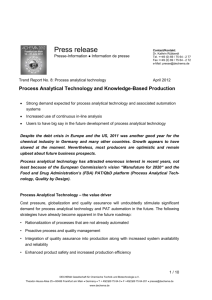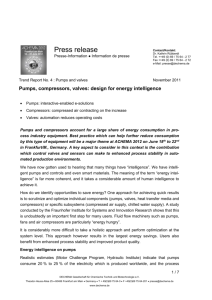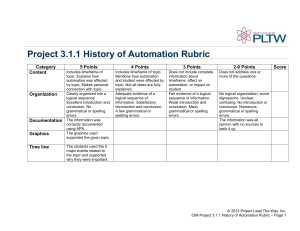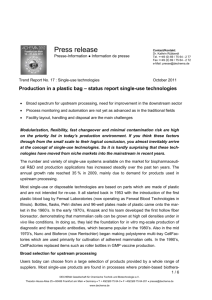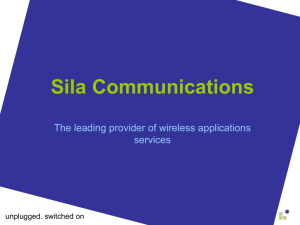doc
advertisement
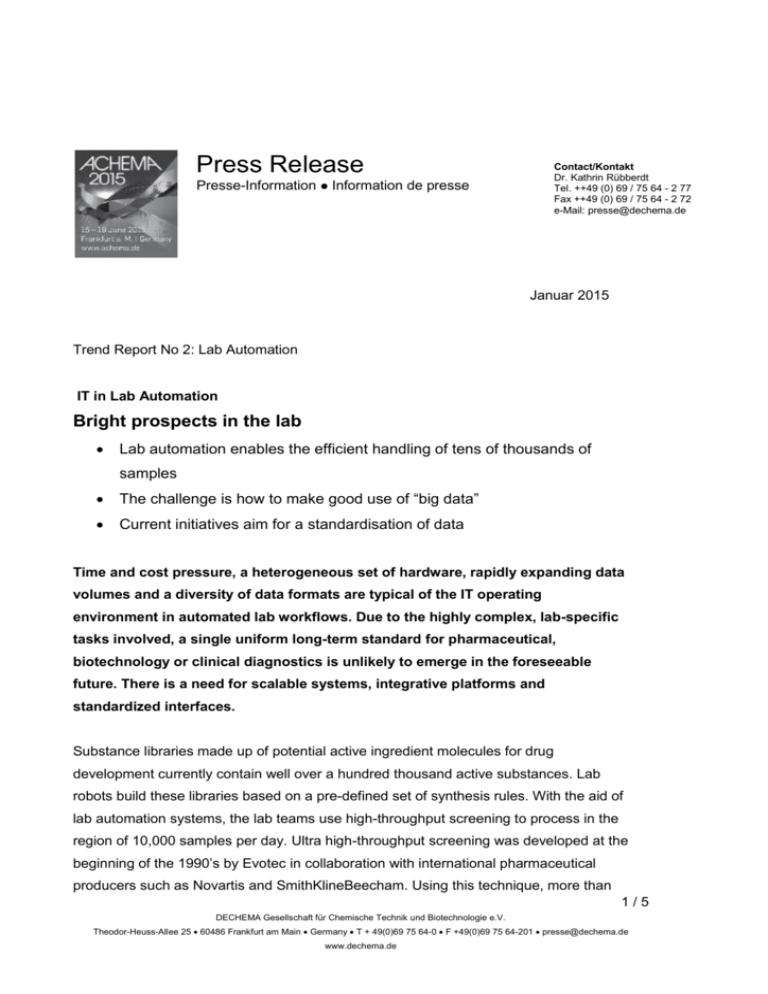
Press Release Contact/Kontakt Dr. Kathrin Rübberdt Tel. ++49 (0) 69 / 75 64 - 2 77 Fax ++49 (0) 69 / 75 64 - 2 72 e-Mail: presse@dechema.de Presse-Information Information de presse Januar 2015 Trend Report No 2: Lab Automation IT in Lab Automation Bright prospects in the lab Lab automation enables the efficient handling of tens of thousands of samples The challenge is how to make good use of “big data” Current initiatives aim for a standardisation of data Time and cost pressure, a heterogeneous set of hardware, rapidly expanding data volumes and a diversity of data formats are typical of the IT operating environment in automated lab workflows. Due to the highly complex, lab-specific tasks involved, a single uniform long-term standard for pharmaceutical, biotechnology or clinical diagnostics is unlikely to emerge in the foreseeable future. There is a need for scalable systems, integrative platforms and standardized interfaces. Substance libraries made up of potential active ingredient molecules for drug development currently contain well over a hundred thousand active substances. Lab robots build these libraries based on a pre-defined set of synthesis rules. With the aid of lab automation systems, the lab teams use high-throughput screening to process in the region of 10,000 samples per day. Ultra high-throughput screening was developed at the beginning of the 1990’s by Evotec in collaboration with international pharmaceutical producers such as Novartis and SmithKlineBeecham. Using this technique, more than 1/5 DECHEMA Gesellschaft für Chemische Technik und Biotechnologie e.V. Theodor-Heuss-Allee 25 60486 Frankfurt am Main Germany T + 49(0)69 75 64-0 F +49(0)69 75 64-201 presse@dechema.de www.dechema.de 100,000 samples can be processed on a daily basis in active ingredient research for the development of new pharmaceutical products. Each microtitration plate can contain up to 3,456 wells to facilitate efficient handling and archiving by automated systems. Lab information and management systems (LIMS) have been in use since the 1980's to integrate lab workflows into the IT landscape, but higher levels of automation greatly increase the complexity of the demands placed on lab IT. This is particularly the case when automated workflows extend beyond PC and microcontroller based control on a single piece of equipment. Attention is currently focused primarily on process and data management as well as inclusive lab management. The big data challenge Data volumes in the world of medicine and research normally extend well into the terabyte and petabyte range. The term “big data” is used to describe the enormous amount of data which is generated during automated processing. Data volumes worldwide are expected to double every two years or so. The enormous increase in data resources for genome sequencing is one example from the Life Sciences. The abundance of data also creates huge potential for development of new drugs and life-sustaining medical analysis. Companies including Boehringer Ingelheim, CHDI, Evotec, Genentech, MedImmune/AstraZeneca, Ono Pharmaceutical and UCB have forged research alliances to develop new pathways for treating Alzheimer’s, diabetes and cancer and for palliative medicine. Insilico Biotechnology operates one of the world’s leading system biology platforms which draws together proprietary data bases, cell models and computer-based analysis. The goals are validation of active ingredients and production of biochemicals and biopharmaceuticals. Highly versatile data analysis Data management designed for the long term is essential for labs which use automation systems. The data must be available in a variety of formats to support data exchange with other labs as well as for distributed access to the lab’s own data. The researchers should be able to use the data which is captured in the lab for automatic analysis and graphic representation. Without the need to invest significant amounts of time and money, the results of completed test series can be retrieved for future experiments and analyses, and the results can be also made available to other labs. Data analysis in an interdisciplinary 2/5 DECHEMA Gesellschaft für Chemische Technik und Biotechnologie e.V. Theodor-Heuss-Allee 25 60486 Frankfurt am Main Germany T + 49(0)69 75 64-0 F +49(0)69 75 64-201 presse@dechema.de www.dechema.de context, for example using special data mining algorithms, is gaining momentum in the biosciences. Data mining techniques create new opportunities to detect medical risks. Data mining can also produce tangible value-add in practical healthcare delivery. Comparative prophylaxis, diagnostic and therapeutic data can be accessed for the patient’s benefit at the time when it is needed and analyzed in the overall context. SiLA initiative to create uniform standards A heterogeneous assortment of specialized equipment is currently installed in many biotechnology, pharmaceutical and clinical diagnostics labs. The IT infrastructure has developed over time, and it tends to be disjointed or poorly coordinated. Device drivers and platforms, which are based on uniform standards and can be addressed by products from any manufacturer, create the opportunity to integrate this heterogeneous equipment. To develop sustainable IT solutions for automated lab environments, systems manufacturers, software service providers, system integrators and pharmaceutical and biotechnology companies have joined forces in the SiLA Initiative (Standardization in Lab Automation) to create authoritative standards. The goal of the initiative is seamless integration of lab equipment and IT systems made by different manufacturers based on uniform communication interfaces, device drivers and lab consumables. Highly-specialized experts are assigned by members of the non-profit consortium to technical working groups for joint development of authoritative standards. According to information provided by Fraunhofer IPA (Institute for Manufacturing Engineering and Automation) which is also a member of the SiLA consortium, device and component manufacturers must have their products SiLA certified. The Institute offers a consultancy service as well as subsequent automatic conformity testing and certification. Further information on SiLA and participating companies is available at http://www.sila-standard.org. iLAB software platform Some initial suppliers such as infoteam Software already market lab automation software platforms which come with interfaces based on existing standards and can be modified to suit individual needs. Institutes including Fraunhofer IPA apply the knowledge gained through their involvement in SiLA to tailored lab IT. According to information provided by the supplier, the platform iLAB is built around the iLAB Service Host and a high-performance 3/5 DECHEMA Gesellschaft für Chemische Technik und Biotechnologie e.V. Theodor-Heuss-Allee 25 60486 Frankfurt am Main Germany T + 49(0)69 75 64-0 F +49(0)69 75 64-201 presse@dechema.de www.dechema.de database. The system features an open device integration module and runs standardized interface protocols (SiLA, OPC, u. a.). The platform accommodates other analysis or experiment planning software tools. If needed, the platform can be integrated into higherlevel systems via a standardized data interface (e.g. HL7, ASTM, SiLA Data Exchange Standard). Provision has also been made for control feedback loops in ongoing processes to support online process optimization. The experiment management hierarchy on the platform's user interface has been designed specifically to facilitate data exchange in interdisciplinary teams or alternating projects. Users have the option of working simultaneously on different aspects of a project and they can consolidate and coordinate data from various sources. The supplier claims that the device-independent software platform is also suitable for use in bioprocess development. Autobio: automating biotechnology processes Biotechnology production is generally considered to be sustainable and resourcefriendly. Experts predict that within 20 years, around one-third of worldwide production will be biotechnology based and that includes pharmaceuticals, biocatalysts and basic and special chemicals. Under the umbrella of the Research on Production of the Future framework, the German Ministry of Education and Research (BMBF) is contributing to this evolutionary trend through its support for the Autobio consortium. The consortium brings together five mid-tier companies along with researchers at TU Berlin who are investigating pathways for automating bioprocessing. The goal is to partially automate bioprocess development which currently takes between five and eight years. By pooling interdisciplinary expertise in biotechnology, IT, process engineering and electrical engineering, the researchers hope to migrate manual development steps to robotic platforms. BMBF will provide a total of 2.2 million euros in funding for Autobio through 2015. The overall project budget is 3.7 million euros. Custom automation Lab automation has many benefits, but it can involve cost-intensive modifications depending on the lab's size and requirements profile. Cost-conscious lab operators who intend to introduce automation step-by-step could well benefit from modular systems which can be expanded as needed. To make the systems as future-proof as possible, 4/5 DECHEMA Gesellschaft für Chemische Technik und Biotechnologie e.V. Theodor-Heuss-Allee 25 60486 Frankfurt am Main Germany T + 49(0)69 75 64-0 F +49(0)69 75 64-201 presse@dechema.de www.dechema.de the modules should conform to current international standards and include standardized interfaces. Outlook Lab automation requires the integration of a wide range of suppliers of soft- and hardware. The challenge today is not to gather more data, but to make good use of the overwhelming amount of information. ACHEMA 2015 offers the opportunity to users, suppliers and service providers to discuss these questions. www.achema.de ((Box start)) Requirements profile for lab IT which is fit for the future Standardized interfaces (SiLA, OPC) Conformance to international standards Integration of heterogeneous device profiles Connectivity to higher-level systems (HL7, ASTM, SiLA Data Exchange) Modular software architecture High-performance data processing Data visualization, analysis and comparability User interface (GUI) which is easy to understand Long-term availability of the software base Distributed access User-centric, adaptable operation High data availability Integratable long-term archive Skilled staff to maintain and use the lab IT systems ((Box finish)) 9.024 characters ACHEMA Trend Reports are compiled by specialized international journalists. DECHEMA is not liable for incomplete or inaccurate information. ACHEMA Trend Reports can be used for editorial purposes free of charge; the source has to be named (more details on www.achema.de) 5/5 DECHEMA Gesellschaft für Chemische Technik und Biotechnologie e.V. Theodor-Heuss-Allee 25 60486 Frankfurt am Main Germany T + 49(0)69 75 64-0 F +49(0)69 75 64-201 presse@dechema.de www.dechema.de
